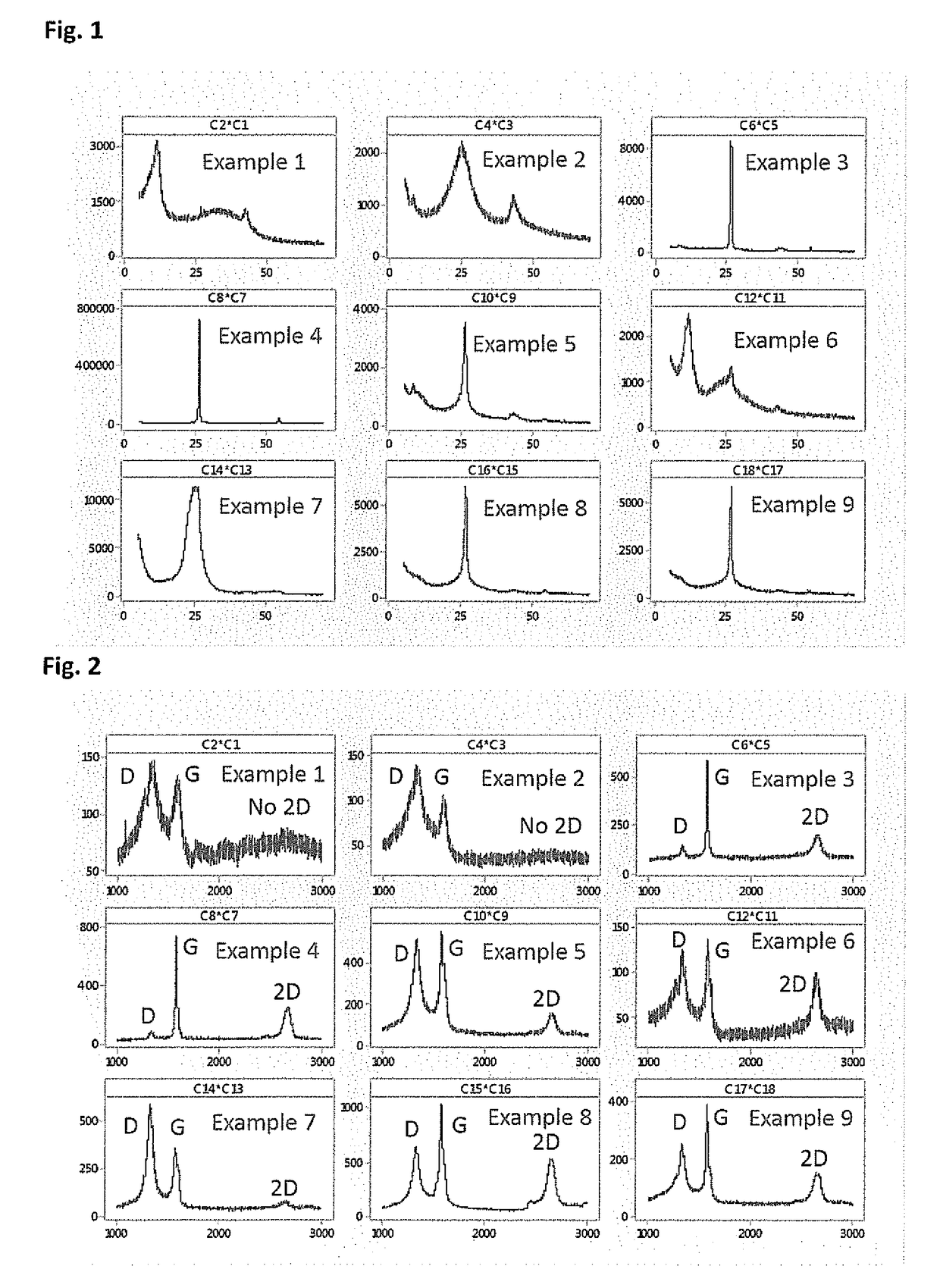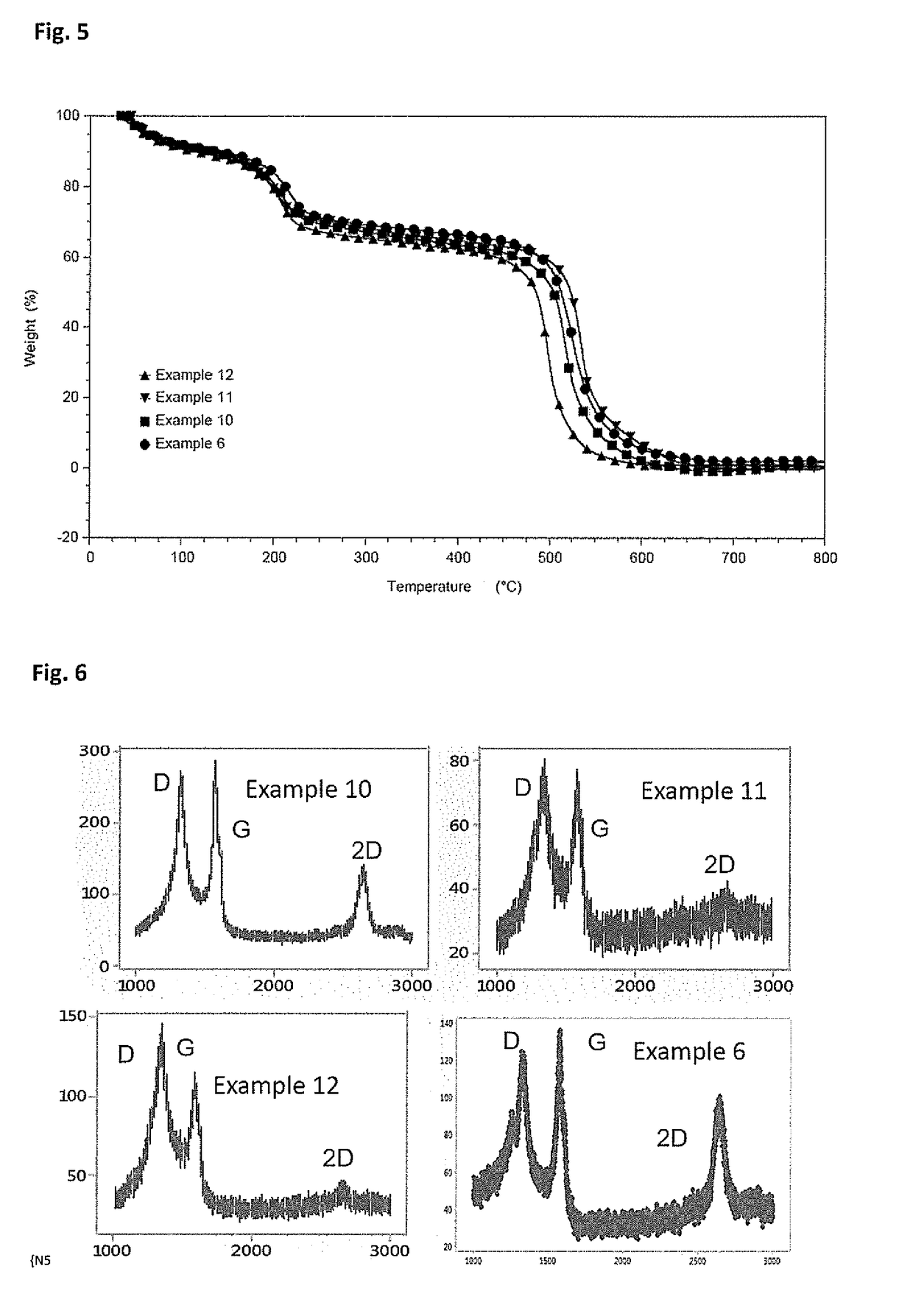Production of Graphene
a graphene oxide and graphene technology, applied in the direction of electrolysis components, chemistry apparatus and processes, electrolysis processes, etc., can solve the problems of limited use of graphene for commercial applications, difficult to produce graphene oxide using these methods, and inability to meet the requirements of large-scale commercial applications, etc., to achieve high volume manufacturing capability, low cost, and high quality
- Summary
- Abstract
- Description
- Claims
- Application Information
AI Technical Summary
Benefits of technology
Problems solved by technology
Method used
Image
Examples
example 1
[0081]GO was prepared by using a modified Hummers' method. In a typical reaction, ˜50 ml conc. H2SO4 was added to ˜1 g of NaNO3 followed by stirring in an ice bath for ˜15 min. 1 g of natural graphite powder was then added to it and stirred for ˜15 min. After this step, 6.7 g KMnO4 was added to it very slowly while stirring in an ice-bath and it was stirred for ˜30 min. The ice bath was then removed and it was then kept at 40° C. for ˜for ˜30 min. 50 ml D.I. H2O was added to it very slowly to it while stirring. The inside temperature in the beaker increased to ˜110° C. and at that temperature it was again stirred for ˜15 min. 100 ml of warm H2O was then added to it at last followed by 10 ml of 30 vol % H2O2. The reaction stopped and it was allowed to cool down to room temperature. The final product was isolated via centrifugation and washed with D.I. H2O several times to remove all the acidic waste and other water soluble unreacted stuffs. Finally, it was wa...
example 2
ion of Reduced Graphene Oxide-rGO)
[0083]In a typical reaction, 1 g of solid pre-exfoliated graphite oxide (prepared via Modified Hummers' method) was dispersed in 0.5 L of D.I. H2O through ultra-sonication for ˜2 h.˜0.5 ml N2H4.H2O was then added to it. It was then refluxed at ˜80° C. overnight, while stirring. The color became brown to black on the next day and the final product settled down at the bottom of the flat-bottom flask. The final product was then isolated through filtration and washed several times with D.I. H2O and then washed with acetone for drying purposes. The final supernatant pH was around ˜6 and it was then kept in an oven for final drying at ˜60° C.; weighed then. The weight of the final product was ˜0.5 g. In FIG. 1 the PXRD pattern of Example 2 shows the characteristic broad peak centered around 2θ˜25° which clearly depicts removal of functional groups from the graphitic backbone (decrease in the inter-layer distance) and thereby restacking of layers in z-dire...
example 3
ally Available Graphene: CG-1)
[0084]Example 3 was procured from a commercial supplier, having average flake diameter of ˜15μ with 6-8 layers for our external benchmarking purpose. The PXRD pattern of example 3 given in FIG. 1, shows a sharp bulk graphitic peak centered on 2θ˜25°. This signifies the long range ordered structure along z-direction. The characteristic Raman spectrum of example 3 (FIG. 2), shows very low ID / IG value than the other examples, which signifies the extent of fewer defects on it. The TGA curve of example 3 (FIG. 3) shows good thermal stability in air, shows existence of a fewer number of functional groups on its' surface. FIG. 4 (Example 3) shows micron range flakes as evident from the SEM images.
PUM
 Login to View More
Login to View More Abstract
Description
Claims
Application Information
 Login to View More
Login to View More - R&D
- Intellectual Property
- Life Sciences
- Materials
- Tech Scout
- Unparalleled Data Quality
- Higher Quality Content
- 60% Fewer Hallucinations
Browse by: Latest US Patents, China's latest patents, Technical Efficacy Thesaurus, Application Domain, Technology Topic, Popular Technical Reports.
© 2025 PatSnap. All rights reserved.Legal|Privacy policy|Modern Slavery Act Transparency Statement|Sitemap|About US| Contact US: help@patsnap.com



